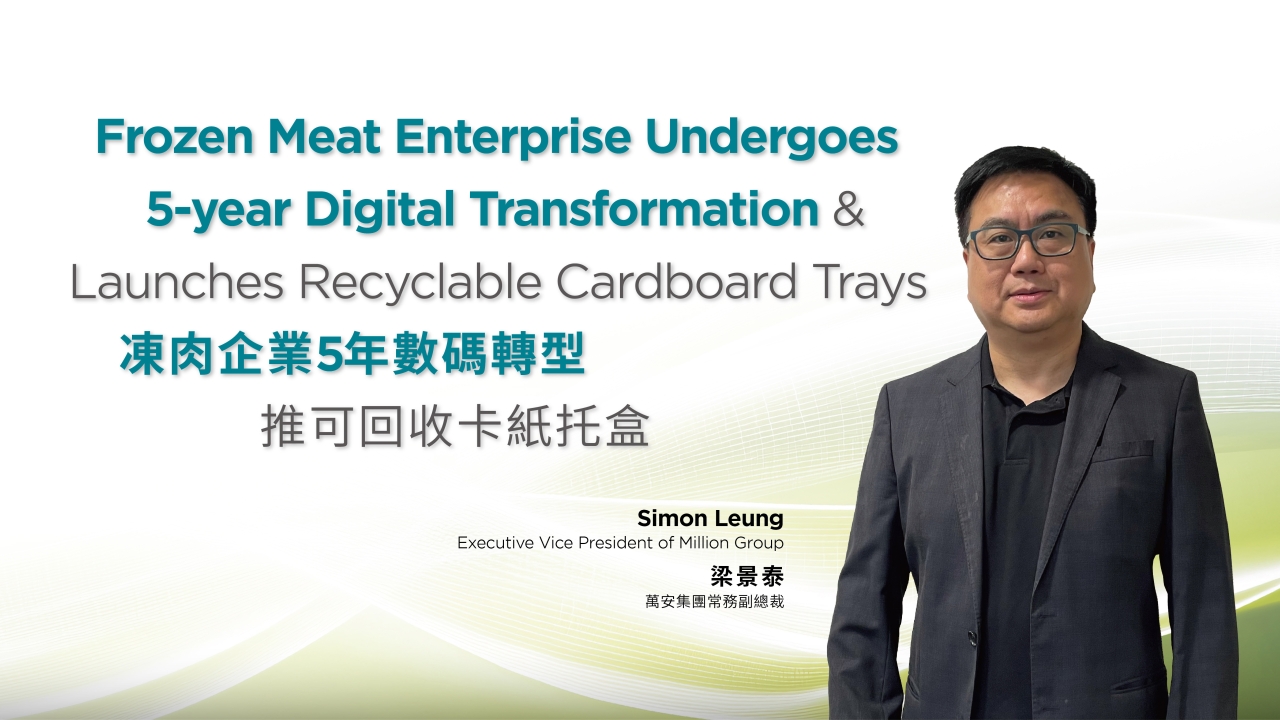
Frozen Meat Enterprise Undergoes 5-year Digital Transformation & Launches Recyclable Cardboard Trays
The frozen and chilled food industry are often stereotyped, connected with traditional business models and limited advancement. Simon Leung, Executive Vice President of Million Group, also acknowledges that innovation in the frozen meat sectors is relatively slow, so he is committed to shaking the status quo since taking office 5 years ago, exploring various software / hardware adoption. Some of them include a 3D scanning-enabled meat cutter, an “Ordering App” for frontline sales, and real-time fleet management systems for fulfillment. The goals are to add value to their professional services, enhance competitiveness, and increase customer confidence and satisfaction.
Meat Cutter with Minimal Discrepancy
Founded 23 years ago, Million Group’s customer generally come from 3 streams: wholesale, "end users" and retail, of income split roughly into 40%:40%:20%. Striving to grow the latter two markets, Simon explained that while wholesale clients are price-sensitive instead of requiring value added services, the "end users" like restaurant chains, caterers and hotels, as well as retailing clients such as PARKnSHOP, Wellcome and YATA, require ingredients to be cut and packaged into equal portions for cooking or sale. This plays to the group’s strengths.
“3 years ago, we bought an industry-leading cutting machine, which uses laser scanning to convert a large chunk of meat into a 3D model, measuring the density of different parts and cut into equal portion of no more than 2.5% deviation. As the saying goes, 'many a little makes a mickle', this machine allows us to have 1 more portion for each chunk of meat, therefore it has been very well received by both chain restaurants and small retailers.”
Sourced and shipped from the globe mostly, the merchandises are unloaded and transported to the Million Group Centre, where a 9-storey, 20,000 sqft. per floor frozen storage located. Simon noted ensuring the food items remain high-quality and safe along the chain is no simple task.

“In summer time, the loading areas and the cargo part of parked trucks are usually scorching hot. The carton boxes that holds the frozen goods may be dampen and soften due to condensation in the heat, even though the food itself remained cold, but it may cause concern for a few clients. So now we've installed cold air curtains in the loading area to keep the cold air in, whereas all trucks are upgraded to enable pre-cooling before goods loading.”
Attentive to details, Simon believes that these tiny yet important changes, together with the value-added services, are actually the group's key success factors and the reasons to winning clients’ trust.

Real-Time Data Boosts Logistics Efficiency by 7%
Million Group deployed GS1 HK's ezTRADE as early as 2007 to send & receive orders and invoices electronically. They further adopted the gateway solution to connect with its ERP (Enterprise Resource Planning) system, which convert EDI messages to SAP standard format, processing an average of about 500 orders and invoices per month seamlessly. “Our office staff used to manually input the POs and the completed order into the system for cross-check and reconciliation, which was prone to errors and inefficient, especially for the documents with discrepancies between orders and deliveries. Now, the crew can simply upload delivery orders to the system in real-time for processing with minimal human intervention, slashing a significant 75% of time to process EDI orders. This in turn allow our crew to focus on the value-added tasks."
Equipped with GPS, the company’s fleet of over 20 trucks are supported by Transportation Management System (TMS) along with GS1 global data standards. This allows employees to easily scan and confirm deliveries of various kinds of foods to different chain restaurants and retail stores, eliminating the need for manual verification and ensuring accurate deliveries.

“The delivery window each day is about 6.5-7 hours. To optimize the delivery routes, we tap into technologies that ask staff to upload real-time delivery fulfillment data to learn about the live traffic conditions, so that we can then make immediate adjustments, and take as reference our future planning. Assuming each truck route is optimised with extra 30 mins for delivery, we can have around 7% of efficiency gain in total. Hypothetically we can reduce the size of the fleet, for example cutting 1 truck to save about HK$1 million in costs a year.”

New Bottle, Old Wine: Maintaining Quality with New Approaches
Dedicated to driving digitalisation, Simon found the biggest challenge is the people. “Some veteran staff are used to their original ways, and we need tangible benefits to create synergy and progress together. For example, our frontline sales team used to rely on back-office support for order placement, which sometimes led to mistakes in the items ordered or quantities, due to miscommunication or staff changes. We draw on a mobile ‘Ordering App’ to streamline the process. Now, our frontline colleagues can easily access clients’ past orders from the last 60 days on their phones as reference when making orders for clients, whereas the back office can thereby process at once. The new system has reduced error and helped them finish work quickly, so they are very willing to learn and use it.”
Striving to go green, Million Group hopes to use new materials to replace the 100% plastic packaging that the frozen meat industry has been using. The most feasible option is paper trays, which can reduce the overall plastic usage by over 70%.


“Our peers in Europe has been using environmental friendly packaging which is not available in Asia yet. We found a supplier recently, although the material is slightly more expensive, we decided to use it to support our green agenda. We hope to lead by example by sowing this seed of sustainable packaging in the industry, ultimately inspire a paradigm shift in this traditional plastic food packaging practice, that consumers used billions of units annually. ”

